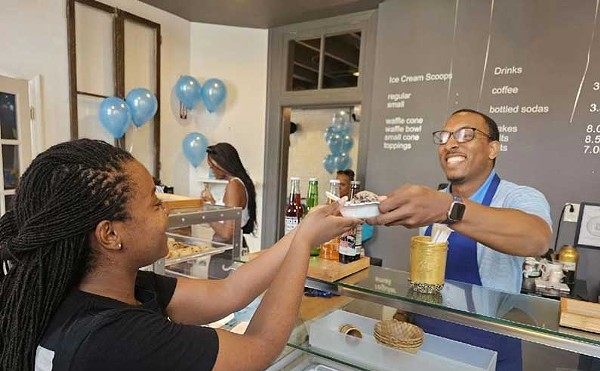Miso on Meramec presents the former scenario. The buttoned-down dude turned impresario is one Bradley Beracha, formerly a consultant with PricewaterhouseCoopers. The initial evidence indicates that he was a pretty good consultant; he had the good sense to assemble a team, first of advisors and then of key employees, to ensure that all of his bases were covered in putting together a brand-new and unproven concept for Clayton's already highly competitive restaurant community. Early on, Pablo Weiss (best known as the mastermind of the original Hot Locust and current owner of the Rocket Bar) and Michael Johnson (of Café Mira, a few doors down from Miso) provided ideas on food, concept and design. When it came time to find someone to head up the kitchen, Beracha recruited Hayes Green, who knew the Asian/fusion style from his days at Globus in San Francisco, as well as in Sun Valley, Idaho, as executive chef. Tetsushi Tanaka, who is most recently of Portland but also worked in Boston and owned two restaurants in Dallas, signed on as sushi chef.
The result is a restaurant with many layers, reflected on first impression by its place in the Clayton streetscape. Located in a storefront in the diminishing low-rise retail portion of the downtown core, at first Miso looks like a tiny place, a few tables outdoors and maybe a half-a-dozen more inside -- your basic small, family-run sushi bar. Yet the heart and soul of Miso, as well as many of its multiple personalities, is invisible from the street, down a staircase in a stainless-steel-trimmed, technologically energized bilevel basement space -- part long bar, part plush-couch sake and martini lounge, with a couple of table areas complementing the ones upstairs and reinforcing the idea that this is, in fact, supposed to be first and foremost a place to dine.
And here again, even the way you order and eat your meal is unusual. The menu -- or, rather, the menus, because there are several -- at Miso include a long sushi list of both traditional and modified items, as well as a second "dinner menu" divided into salads, soups and noodles, and tapas, the overused and frequently misused descriptor that nowadays roughly translates as "order three or more of these where you would normally order two entrées for two people."
In short, look for a high-definition flat-panel TV alternating scenes of tropical fish, wildlife documentaries and clips from the Kyle MacLachlan version of Dune and a fair amount of primarily twenty- and thirtysomething socializing, all in a windowless, navy-blue-walled, black-ceilinged space that's metaphorically miles away from anything else in Clayton. Even with all the distractions, though, we were able to carry on normal-volume conversations with few impediments. (If you want to keep the atmosphere on the sedate side, by the way, ask to be seated upstairs when you make your reservation. And do make a reservation, especially for Fridays and Saturdays.)
Perhaps the biggest quandary in eating at Miso is deciding on a direction. Each of our servers on successive visits suggested moving from category to category with as much sharing as possible, and that allowed us to wade through a variety of sushi and sashimi and a special grilled category called miso-yaki on the sushi menu; all three of the available noodle selections; and a majority of the dozen so-called tapas. Mr. Green and Tanaka-san are an interesting culinary tag-team -- aside from some experimental stuff, such as a "Cajun" maki that included crawfish (remarkably well textured, as if it had in fact been freshly steamed that day) and spicy "dynamite" versions of the miso-yaki, Tanaka-san plays his sushi fairly straight, keeping a keen eye on freshness and illustrating an even keener eye for the gorgeous simplicity of classic presentation. This was most evident in a sashimi sampler of Hokki clam, tuna, salmon, octopus, mackerel, flounder and scallops, a couple of the items delicately colorized with bright-orange roe and everything laid out just so with nests of pure-white shredded daikon and strategically placed lemon halves and wedges.
Green, on the other hand, freely flits from country to country in search of both expected and unexpected Asian complements for traditional Asian preparations, as well as for distinctly more Western items, such as calamari and a vegetable terrine. There's simple stuff such as chicken satay, five skewers of grilled chicken grilled under such a hot flame that the wood picks were almost disintegrating when the dish arrived, although the chicken was ideally roasted. And there's fairly wild stuff, such as a whole, mostly boned pan-roasted quail, moist, succulent and sweet from several different directions -- a barely perceptible plum-wine glaze, an apple-tart-like chutney and bursts of the concentrated fruit-berry flavor of currants.
Green's crab cakes add a spicy Thai accent through use of chile-garlic Sriracha sauce; his five medium-thick slices of medium-rare tuna have been rubbed with chiles and sesame, plus an additional spice that I took to be citrus peel. This "seven-spice" tuna was the only item I didn't care for in our two meals; I didn't find the hints of bitterness a worthy complement to the fine cut of tuna.
The noodles allow for stand-alone budget meals, but they're also significant enough portions to serve as shared intermediate courses. The Japanese soba, narrow-gauge buckwheat noodles, are chilled, lightly dressed with a peanut sauce and complemented by generous amounts of broccoli, mushrooms, sprouts, carrots and scallion, plus fresh cilantro and a wedge of lime for flavoring. The pad thai had an equally good assortment of still-crisp vegetables, and the lo mein featured a distinctive undertone of oranges. Both of these dishes can include chicken or shrimp (or tofu, in the case of the lo mein) for a small additional charge.
The dessert choices are few; there's a superior ginger crème brûlée in approximately triple size, and special recognition is owed to the utterly fabulous ice creams and sorbets, two large scoops to a serving. The ice creams -- we tried a coconut and a "five spice" of pumpkin-pie-spice flavors -- were every bit as rich as triple-crème cheeses and tactfully underdone in their sweetness, and the sorbet successfully combined the unlikely partners of strawberry and Sambuca.
Beverages are on the high side, with most of the by-the-glass wines running 7 bucks and up, bottles in the high $20-$40 range and plain sake selections and froufrou drinks $5-$12. Although the wine list is short, it features a great variety of regions and varietals, and the restaurant offers some hard-to-find unfiltered and fruit-infused brands of sake.
As one might expect, the staff is a bit brash, not hesitating to become part of your party if the opportunity seems to present itself but also well-trained enough to be able to explain the sometimes exotic preparations and to guide you through the nontraditional methodology of designing your meal.
We're thinking Beracha is going to be very happy at the current count of his beans.





